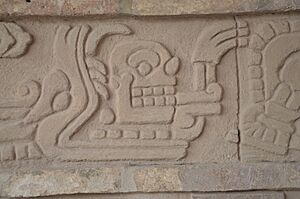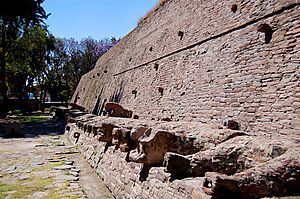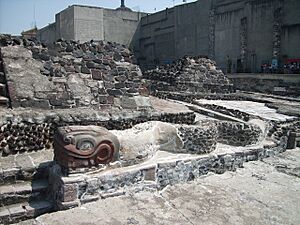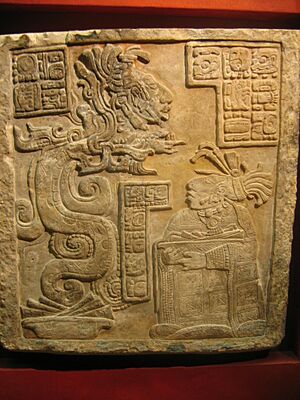Coatepantli facts for kids
Coatepantli is a Nahuatl word that means "wall of serpents." It comes from two words: coatl, meaning serpent, and tepantli, meaning wall. It's a special design or pattern found on ancient buildings in Mesoamerica.
Contents
What Were Coatepantli For?
Experts aren't fully sure why these walls were built. Many thought they marked the edge between important religious areas and regular parts of a city. Sometimes, the word meant any wall around a sacred place, like in Tlatelolco. But newer studies suggest they weren't always clear boundaries between sacred and everyday places. Instead, their meaning might have changed depending on where they were.

Famous Coatepantli Walls
We only know of three Coatepantli walls that still exist today. The oldest one was built at the Tula site between the years 950 CE and 1200 CE. The Coatepantli walls at Tenayuca and Tenochtitlán were built much later, around 1500 CE. Many believe the Tula Coatepantli was the first one, and it inspired the others.
These walls are different not just in where and when they were built, but also in how they look.
The Tula Coatepantli
The Coatepantli at Tula is about 36 meters (118 feet) long. It has carvings that show snakes appearing to eat figures that look like skeletons. Some people think the figures are coming out of the snakes' mouths, while others think the snakes are carrying them.
Originally, the background and the skin of the skeletal figures were painted red. The snakes were painted either blue or yellow, in an alternating pattern. The snakes' teeth and the bones of the skeletal figures were white.
One idea about these carvings is that the snakes represent the earth taking in the dead. It might also suggest the need for human sacrifice to please the gods. Another idea is that the skeletons are images of past kings or brave warriors. In this view, the snakes are not symbols of the earth, but rather signs of royalty. Jorge R. Acosta, who discovered the Tula Coatepantli, thought the skeletal figure was Tlahuizcalpantecuhtli, the Lord of the Dawn, who often had a skeletal face.
Similar carvings can also be found at ancient Pre-Columbian Mayan sites like Chichen Itza and Yaxchilan.
The Tenayuca Coatepantli
The wall at Tenayuca is 170 meters (558 feet) long. It features 138 sculpted rattlesnakes on three sides of the temple pyramid's base. The snakes on the east and west sides were painted green. This color represented Tláloc, the god of rain and fertility. The snakes on the north side were painted red and black. These colors represented Huitzilopochtli, the god of war. Like the Coatepantli at Tula, this wall is thought to represent fire and new beginnings.

The Tenochtitlán Coatepantli
For many years, people thought the wall at Tenochtitlán surrounded the entire sacred area of the city. They believed it had many snakes. This idea came from old stories. But in 1981, archaeologists found something different. They discovered that the city's sacred area went beyond the Coatepantli. The Coatepantli itself was made of two walls shaped like large snakes with painted heads. These snakes surrounded the Templo Mayor. One snake was on the north side of the temple and was painted blue, representing the rain god Tláloc. The other snake was on the southern side and was painted ochre (a yellowish-brown color). This snake represented the war god Huitzilopochtli.

See also
 In Spanish: Coatepantli para niños
In Spanish: Coatepantli para niños


